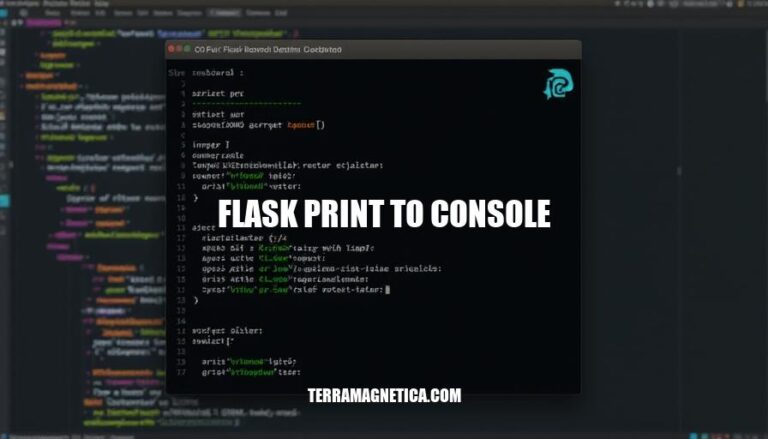


In Flask, printing to the console involves using the print() function to output messages directly to the terminal where your Flask application is running. This technique is crucial for debugging and logging as it allows developers to monitor the application’s behavior in real-time, identify issues, and track the flow of data through the application. By printing key variables and messages, developers can quickly diagnose and fix problems, ensuring smoother and more reliable application performance.
Here’s how to set up a basic Flask application:
Install Flask:
pip install Flask
Create a project directory:
mkdir my_flask_app
cd my_flask_app
Create the main application file:
touch app.py
Write the basic Flask app:
from flask import Flask
app = Flask(__name__)
@app.route('/')
def hello():
print("Flask print to console")
return 'Hello, World!'
if __name__ == '__main__':
app.run(debug=True)
Run the application:
python app.py
This will start the Flask server, and you should see “Flask print to console” in your terminal when you access the root URL (http://127.0.0.1:5000/).
To use the built-in print() function in a Flask application to print messages to the console, follow these steps:
Import Flask:
from flask import Flask
Create a Flask app instance:
app = Flask(__name__)
Define a route and use print() inside the route function:
@app.route('/')
def hello_world():
print("Hello, World!") # This will print to the console
return "Hello, World!"
Run the Flask app:
if __name__ == '__main__':
app.run()
Here’s a complete example of a simple Flask application that prints “Hello, World!” to the console when the root URL is accessed:
from flask import Flask
app = Flask(__name__)
@app.route('/')
def hello_world():
print("Hello, World!") # This message will appear in the console
return "Hello, World!"
if __name__ == '__main__':
app.run()
When you run this Flask application and navigate to http://127.0.0.1:5000/ in your browser, “Hello, World!” will be printed to the console.
In a Flask application, using the flush=True argument with the print() function ensures that the output is immediately flushed to the console, bypassing the default buffering behavior. This is particularly useful for real-time logging and debugging.
Here’s an example:
from flask import Flask
app = Flask(__name__)
@app.route("/")
def index():
print("Hello, world!", flush=True)
return "Check your console!"
if __name__ == "__main__":
app.run()
In this code, print("Hello, world!", flush=True) ensures that “Hello, world!” is immediately printed to the console when the / route is accessed.
Here are some examples of how to print messages to the console from within Flask route functions:
Basic Example:
from flask import Flask
app = Flask(__name__)
@app.route('/')
def hello_world():
print("Hello, World!")
return "Hello, World!"
if __name__ == '__main__':
app.run()
Printing POST Data:
from flask import Flask, request
app = Flask(__name__)
@app.route('/submit', methods=['POST'])
def submit():
print("Form Data:", request.form)
return "Data received"
if __name__ == '__main__':
app.run()
Using sys.stderr for Error Messages:
import sys
from flask import Flask
app = Flask(__name__)
@app.route('/error')
def error():
print("An error occurred!", file=sys.stderr)
return "Error logged"
if __name__ == '__main__':
app.run()
These examples demonstrate different ways to print messages to the console in a Flask application.
Using print statements for debugging in Flask applications offers several benefits:
Simplicity: Print statements are straightforward to implement. You can quickly insert them into your code to check the values of variables or the flow of execution without needing complex setup.
Immediate Feedback: By printing to the console, you get immediate feedback on what’s happening inside your application. This is particularly useful for identifying issues in real-time as you interact with your Flask routes.
No External Dependencies: Unlike some debugging tools, print statements don’t require any additional libraries or tools. This makes them a lightweight option for quick debugging tasks.
Versatility: You can use print statements to output a wide range of information, from simple messages to complex data structures. This flexibility helps in understanding different aspects of your application’s behavior.
Control Over Output: By using the flush=True argument with the print function, you can ensure that the output is printed to the console immediately, which is crucial for real-time debugging.
In summary, using print statements in Flask applications, especially with the flask print to console approach, provides a simple, immediate, and versatile method for debugging. This helps developers quickly identify and resolve issues without the need for complex setups or external tools.
Using print statements in Flask applications offers simplicity, immediate feedback, no external dependencies, versatility, and control over output.
It’s a lightweight option for quick debugging tasks that can be used to output various types of information, from simple messages to complex data structures.
This approach is particularly useful for real-time debugging and identifying issues as you interact with your Flask routes.
By using print statements, developers can quickly insert them into their code to check the values of variables or the flow of execution without needing complex setup.